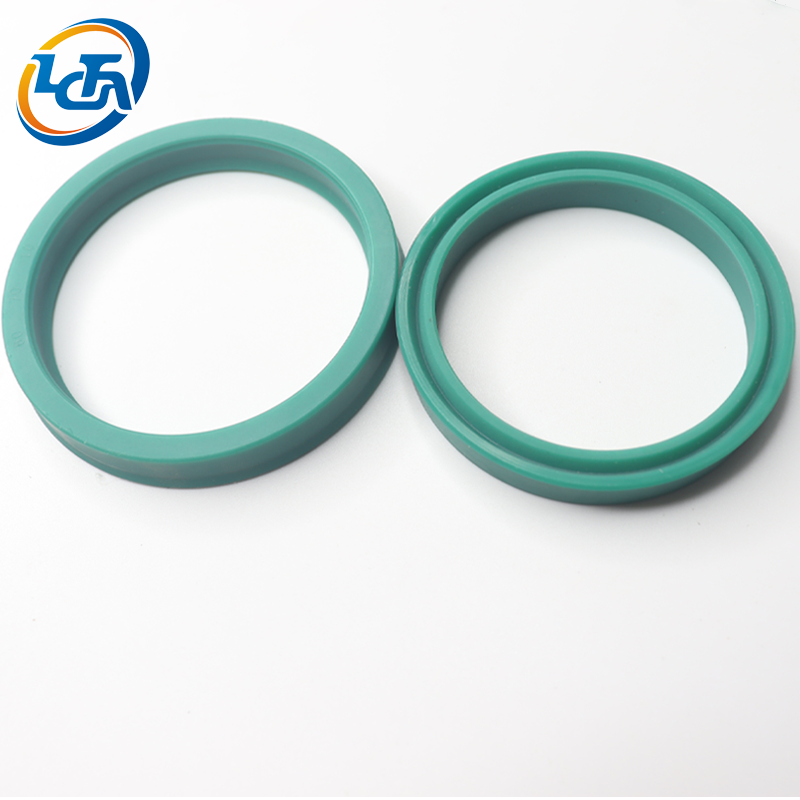Mahahalagang Pamamaraan sa Pangangalaga ng Industrial Seals
Mga Protokol sa Biswal na Inspeksyon para sa Maagang Pagtuklas ng Pagtagas
Ang pagkakaroon ng mabuting plano para sa regular na visual checks ay nagpapagulo ng pagkakaiba kapag sinusubukan na mahuli ang mga leakage bago pa man ito maging malubhang problema sa mga industrial seals. Karamihan sa mga pasilidad ay nakakakita na ang pagtutok sa mga nakatakdang oras ng inspeksyon ay nakakatulong upang mapansin ang mga paunang babala tulad ng kakaibang pagbabago ng kulay o di-pangkaraniwang hugis sa mga materyales na maari pang magpahiwatig ng paparating na pagkabigo. Ang pinakamahusay na kasanayan ay kinabibilangan ng pagsuri sa bawat mahalagang bahagi ng sistema - masusing pinagmamasdan ang mga connection points, rubber gaskets, at ang mga lugar kung saan talaga nakalagay ang seals laban sa mga surface. Ilan sa mga kompanya ay nagsimula nang gumamit ng mas mahusay na kagamitan para sa mga pagsusuring ito. Ang mga borescope ay nagpapahintulot sa mga technician na makita ang loob ng mga hindi maabot na lugar, samantalang ang thermal imaging ay nakakakita ng mga pagkakaiba sa temperatura na nagpapahiwatig ng mga nakatagong leakage na hindi natin makikita ng ating mga mata. Ang pagharap sa mga maliit na isyung ito nang maaga ay nangangahulugan ng mas kaunting hindi inaasahang pagkabigo sa hinaharap at nagse-save ng pera sa matagalang pagtingin dahil ang pag-aayos ng mga bagay nang maaga ay nakakaiwas sa mas malaking gastos sa pagkumpuni sa susunod.
Fluid Analysis and Replacement Strategies
Ang pagsusuri ng fluid ay mahalaga sa pagpapanatili ng mabuting pagganap ng mga selyo sa loob ng matagal na panahon. Kapag regular kaming nagsusuri ng mga sample, nakakakita kami ng mga contaminant bago pa man ito magsimulang sumira sa mga selyo, na nagbibigay-daan sa amin upang malaman ang tunay na komposisyon ng mga fluid na ginagamit namin. Makatutulong din ang pagtatakda ng mga iskedyul para sa pagpapalit. Ang mga salik tulad ng temperatura kung saan ginagamit ang fluid at ang kanilang pagganap habang nasa ilalim ng presyon ay dapat maging gabay sa pagpapasya kung kailan ito dapat palitan. Ang ilang mga pasilidad ay nakikinabang sa pag-install ng mahusay na mga sistema ng pag-filter kasabay ng kanilang regular na pagsusuri. Ang mga filter na ito ay nagpapahaba nang malaki sa buhay ng fluid habang tumutulong na panatilihin ang integridad ng mga selyo, na nangangahulugan ng mas kaunting oras ng pagkakabigo dahil sa kailangang pagkumpuni at mas kaunting pagpapalit ng selyo sa kabuuan. Ano ang resulta? Ang mga sistema ay tumatakbo nang mas maayos sa mas matagal na panahon nang hindi naaabala ng mga hindi inaasahang pagkabigo na nakakaapekto sa operasyon.
Pagkontrol sa Pagbabago ng Temperatura sa Mga Sistema ng Hydraulic
Ang pagkontrol sa temperatura ay mahalaga para sa magandang pagganap ng hydraulic seals. Ang regular na pagsusuri sa temperatura ay nakakatulong upang maiwasan ang pagkasira dahil sa init, at ang pag-install ng mga cooling system kapag kinakailangan ay nakakapigil sa temperatura na lumampas sa limitasyon ng seals. Ang pagtutok sa mga saklaw ng temperatura na tinukoy ng mga tagagawa ay nakakatulong upang mapanatili ang optimal na pagganap ng seals. Ang mga insulating materials at heat exchangers ay mga karaniwang solusyon na talagang epektibo sa pagpapanatili ng matatag na temperatura sa paligid ng sistema. Ang ganitong uri ng atensyon sa mga detalye sa temperatura ay nagdudulot ng malaking pagkakaiba sa pagpapanatiling makinis ang pagtakbo ng hydraulic systems nang walang inaasahang pagkasira o pagkasuot ng mga bahagi nang maaga.
Mga Mahalagang Salik na Nakakaapekto sa Katiyakan ng Seal
Kakayahang Magtrabaho ng Materyales kasama ang Process Fluids
Ang pagkakatugma ng materyales ay mahalaga upang mapanatili ang tamang pagpapaandar ng mga selyo sa mga industriyal na kapaligiran. Una sa lahat, pumili ng mga materyales para sa selyo na talagang magiging tugma sa mga likido na kanilang makikita sa panahon ng operasyon. Kung mali ang pagpili, maaari itong magdulot ng iba't ibang problema sa hinaharap tulad ng pamam swelling, pagkakorrosion, o kahit na pagkabiyak dahil sa reaksiyon ng kemikal. Karamihan sa mga pabrika ay sumusunod sa mga pamantayang proseso ng pagsubok upang masuri ang pagkakatugma bago ilagay ang mga ito, na nagse-save ng pera sa mga pagpapalit sa susunod. At huwag kalimutan na bantayan din kung paano maaaring magbago ang komposisyon ng mga likido sa paglipas ng panahon. Kahit ang mga maliit na pagbabago sa likido na dumadaan sa sistema ay maaaring unti-unting makapinsala sa integridad ng selyo. Ang ganitong uri ng maingat na pagtugon ay nakatutulong nang malaki upang maiwasan ang hindi inaasahang pagkabigo at mapanatili ang maayos na produksyon nang walang patuloy na paghihinto.
Tama at Propesyonal na Paraan ng Pag-install Upang Maiwasan ang Hindi Tama sa Alignment
Ang pagkuha ng tamang pag-install mula sa umpisa ay nagpapakaibang-ibang sa pag-iwas sa mga problema sa misalignment ng seal na nagiging sanhi ng pagkabigo sa hinaharap. Kapag alam ng mga manggagawa kung paano nang tamang i-align ang mga seal habang isinu-install, binabawasan nila nang malaki ang mga isyu na dulot ng hindi pantay na pagsusuot at abala na mga vibration sa buong sistema. Ang mga espesyalisadong kagamitan tulad ng laser alignment tools ay talagang tumutulong sa mga tekniko na maayos ang mga kritikal na puntos ng contact sa pagitan ng mga mating surface. Bago magsimula nang tunay sa anumang sealing work, matalino na suriin muna ang alignment ayon sa mga itinakdang pamantayan. Ang simpleng hakbang na ito ay nakakatipid ng pera at problema sa hinaharap. Kailangan ng buong proseso ang maingat na pagbabantay sa detalye at karanasan sa pagtatrabaho sa iba't ibang uri ng seals sa iba't ibang aplikasyon. Ang tamang teknik ay hindi lamang nagpapanatili ng maayos na pagpapaandar ng seals kundi pati na rin ay nagpapahaba nang malaki ng kanilang lifespan.
Mga Rekwisito sa Pagpapadulas para sa Matagalang Pagganap
Ang pagkuha ng tamang dami ng lubricant na inilapat sa mga selyo ay nagpapakaibang-iba sa tagal ng kanilang buhay. Ang uri ng selyo at ang uri ng kapaligiran kung saan ito gumagana ay nagdedetermine kung aling paraan ng pagpapadulas ang pinakamabisa. Halimbawa, ang ilang mga pang-industriyang selyo ay nangangailangan ng espesyal na mga grasa habang ang iba ay maayos lamang gamit ang karaniwang langis. Ang regular na pagtsek sa antas ng pagpapadulas ay nagpapanatili sa maayos na pagtakbo ng mga selyo nang hindi masyadong mabilis na nasusugatan. Dapat alamin ng mga grupo ng pagpapanatili kung ano ang mangyayari kapag may sobra o kulang na lubricant dahil parehong maaaring makapinsala sa kagamitan ang dalawang sitwasyong ito. Ang pagtatakda ng malinaw na gabay para sa mga gawain sa pagpapadulas ay nakatutulong upang manatiling nasa parehong pahina ang lahat. Kapag maayos na isinagawa, ang mga pangunahing hakbang sa pagpapanatili na ito ay nagpapanatili sa pinakamataas na pagganap ng mga selyo, binabawasan ang mga pagkabigo, at sa huli ay nakatitipid ng pera sa mga gastos sa pagpapalit sa paglipas ng panahon.
Karaniwang Dahilan ng Selyo na Pagbagsak sa Mabigat na Makinarya
Epekto ng Dry Running at Thermal Shock
Kapag ang mga selyo ay tumatakbo nang tuyo o nakakaranas ng thermal shock, mas maaga silang nabigo kaysa inaasahan sa mga industriyal na kagamitan. Ang dry running ay nangyayari kapag kulang ang pangpalambot sa pagitan ng mga gumagalaw na bahagi, na nagdudulot ng labis na pag-init at mabilis na pagsuot. Lumalaki ang pinsalang ito hanggang sa selyo ay tuluyang mabigo. Ang thermal shock ay gumagana nang iba pero kapareho ng pagkasira. Ang biglang pagbabago ng temperatura, tulad ng nakikita sa mga yugto ng startup o shutdown, ay maaaring talunin ang mga ibabaw na metal o masira ang mga compound ng goma sa mga selyo, na nagdudulot ng pagtagas. Ang tamang pag-install ng mga sensor ng temperatura sa buong sistema ay tumutulong upang mahuli ang mga mapanganib na spike bago pa man maging sanhi ng tunay na pinsala. Karamihan sa mga pasilidad ay nakakakita na ang pagsasama ng regular na visual checks at pangangalaga nang ilang beses sa isang buwan ay nakakapigil sa mga problema sa selyo. Ang ganitong paraan ay hindi lamang nakakatipid ng pera sa mga emergency repair kundi nagbibigay din ng mas matagal na buhay sa mga makina nang walang inaasahang pagkabigo.
Vibration-Induced Seal Face Separation
Ang labis na pag-vibrate sa malalaking makinarya sa industriya ay kadalasang nagdudulot ng paghihiwalay ng mga seal face mula sa isa't isa, na isa sa mga pangunahing dahilan kung bakit nabigo ang mga seal. Ang regular na pag-check ng kagamitan para sa mga ganitong pag-vibrate ay nagpapahintulot sa mga technician na mapansin ang mga problema tulad ng misalignment o imbalance bago pa ito maging malubhang isyu. Karamihan sa mga shop ngayon ay gumagamit ng mga espesyalisadong tool sa vibration analysis upang madaling matukoy ang mga problemang ito sa alignment upang mabigyan ng solusyon bago pa man umabot sa pagkasira. Kapag naunawaan ng mga grupo ng maintenance ang kahalagahan ng pagkontrol sa vibration, ang mga seal ay karaniwang mas matagal ang buhay dahil nabawasan ang pagsusuot sa paglipas ng panahon. Ang kabuuang sistema ay naging mas maaasahan din. Ang mga kompanya naman na nagpapatupad ng mahigpit na vibration monitoring programs ay nakakaranas ng mas kaunting insidente kung saan ang mga seal face ay naghihiwalay dahil sa labis na pagshake, at mas mainam ang pangkalahatang pagganap ng makinarya sa buong operasyon.
Kimikal na Pagkasira ng Mga Bahagi ng Pang-sealing
Ang mga sealing component ay nakakatagpo ng seryosong problema mula sa mga kemikal na pagkabulok kapag nalantad sa agresibong mga sangkap sa kanilang kapaligiran. Upang mapigilan ang ganitong pagkasira, matalino ang pag-aaral kung paano nakakaapekto ang iba't ibang kemikal sa mga sealing material depende sa lugar kung saan ito ginagamit. Maraming mga planta ang naglalagay ng mga monitoring equipment na nagsusuri sa komposisyon ng mga likidong ginagamit upang madiskubre nang maaga ang mga mapanganib na reaksyon bago masira ang mga seal. Para sa mga pasilidad na nakikitungo sa talagang matinding kondisyon, mahalaga na umangkop sa paggamit ng mga seal na gawa sa mga materyales na lumalaban sa kemikal na pag-atake. Ang regular na pagsusuri para sa kemikal na tugma kasama ang matalinong pagpili ng materyales ay nagbibigay-daan sa mga tagagawa na makalaban sa pagkasira. Pinapanatili nito ang maayos na pagpapatakbo ng mga seal nang mas matagal habang binabawasan ang mga gastos sa pagpapalit sa iba't ibang industriyal na aplikasyon.
Mga Advanced na Teknik para sa Pagsubaybay sa Kalagayan ng Selyo
Imaheng Termal para sa Pagtuklas ng Hotspot
Ang paggamit ng thermal imaging cameras sa pang-araw-araw na operasyon ay makatutulong upang mapansin ang mga mainit na bahagi na maaaring magdulot ng problema sa mga seal sa hinaharap. Ang mga camera na ito ay nagbibigay-daan sa mga tauhan ng maintenance na makita ang pagkakaiba-iba ng temperatura sa ibabaw ng mga kagamitan, na nagpapakita ng mga paunang babala bago pa man masira o tuluyang bumagsak ang mga seal. Kapag nakatanggap nang maayos na pagsasanay ang mga manggagawa sa pagbasa ng mga thermal image, mas mabilis nila matutukoy ang mga problema at agad nang mapapataan ng tamang aksyon imbes na maghintay pa ng mas malubhang isyu. Maraming pasilidad ang nag-uugnay ng thermal checks kasama ang vibration analysis, upang makabuo ng mas kumpletong larawan kung paano nasisuportahan ng mga seal ang paggamit sa loob ng panahon. Ang ganitong multi-angle na paraan ay makatutulong upang mapanatili ang maayos na pagtakbo ng lahat habang nahuhuli ang mga posibleng pagkabigo bago pa man magdulot ng tunay na pinsala.
Vibration Analysis upang Matukoy ang Imbalance Issues
Kapag isinama ng mga kumpanya ang pagsusuri ng vibration sa kanilang mga plano sa predictive maintenance, nakakakuha sila ng mahalagang impormasyon tungkol sa kondisyon ng mga seals. Ang mga modernong tool sa pagmamanman ng vibration ay makatutulong upang mapansin ang mga problema bago ito maging malubha na maaaring makapinsala sa seals. Ang pagsusuri sa mga reading na ito ay nagbibigay-daan sa mga technician na baguhin ang mga setting o iskedyul ng makina upang ang mga maliit na isyu ay hindi magbalang magresulta sa kabuuang pagkabigo ng seals. Ang tunay na bentahe ay nasa paggamit ng datos na nakolekta at hindi lamang sa pagkuha nito. Ang mga seals ay mas matatagal kapag napanatili nang maayos batay sa aktuwal na mga pagsukat kaysa sa hula-hula. Bukod pa rito, ang ganitong paraan ay nagtatag ng mas mahusay na mga gawi tungkol sa regular na pagsusuri at pangangalaga nang maaga sa buong pasilidad, isang kasanayan na karamihan sa mga manual ng maintenance ay inirerekumenda naman para mapanatiling maayos at walang biglang pagkabigo ang mga makinarya.
Pagsukat ng Leak Rate para sa Predictive Maintenance
Ang mga sistema ng pagmamatyag sa rate ng pagtagas ay talagang mahalaga para matuklasan ang mga problema sa selyo bago pa man ito mangyari. Kapag nauna nating itinakda ang normal na benchmark para sa rate ng pagtagas, ang anomaliyang pagbabago na nagpapahiwatig ng pagkasuot ng mga selyo ay mas maagang makikita. Nagbibigay ito ng oras sa mga tekniko para ayusin ang mga problema bago pa lumala. Lahat ng impormasyong nakalap ay nakatutulong sa pagplano kung kailan at saan ilalaan ang mga mapagkukunan, upang ang mga pagkumpuni ay maisagawa nang tama sa unang pagkakataon, nang hindi nasayang ang pagsisikap sa mga hindi kinakailangang gawain. Sa pagtingin sa hinaharap, ang ganitong klase ng predictive maintenance ay nakababawas sa mga biglang paghinto at nagpapabuti sa kabuuang proseso ng pagpapanatili. Patuloy na tumatakbo nang maayos ang operasyon habang nakakatipid din ng pera ang mga kompanya sa pamamagitan ng matalinong paggamit ng kanilang mga mapagkukunan imbes na tugunan lamang ang mga problema habang nagaganap.
Pinakamahusay na Kasanayan para sa Pagpapanatili ng Dry Gas Seal
Kalinisan ng Suplay ng Gas at Mga Pamantayan sa Filtrasyon
Mahalaga ang pagpanatili ng kalinisan ng suplay ng gas kung nais nating maiwasan ang mga hindi magandang resulta ng seal failures na dulot ng kontaminasyon. Kailangan magkaroon ng maayos na sistema ng filtration upang manatiling malinis ang gas at matugunan ang mga pamantayan sa kalinisan na pinaguusapan ng lahat. Kailangan din nating regular na subukan ang gas upang matiyak na nasa loob pa rin ito ng mga tanggap na limitasyon. Makatutulong ito upang mapansin nang maaga ang anumang problema bago pa ito maging malaking isyu sa hinaharap. Huwag din kalimutan ang pagsasanay sa mga taong nagtatrabaho sa lugar. Dapat alam nila kung ano ang dapat tandaan kapag may problema na sa kalidad ng gas. Mabilis na aksyon mula sa mga sanay na kawani ay makatitipid ng maraming pera at oras sa kabuuan, habang pinapanatili ang integridad ng mga seal at ang maayos na pagtakbo ng kabuuang sistema.
Iskedyul na Pagpapalit ng Pangalawang Selyo
Kailangan ng mabuting plano para palitan ang mga secondary seal upang matiyak na patuloy na maayos ang pagganap ng ating dry gas seals. Dapat batay ang tamang timing sa mga rekomendasyon ng mga manufacturer at sa tunay na datos mula sa pang-araw-araw na operasyon. Walang gustong maghintay hanggang sa sumabog ang isang bagay dahil ang mga nasirang seal ay nagdudulot ng iba't ibang problema. Mahalaga na tandaan kung kailan palitan ang bawat seal upang mapanatili ang responsibilidad at magbigay ng ideya kung kailan kailangan muli ang maintenance. Ang pagbibigay ng pagsasanay sa mga kawani tungkol sa kahalagahan ng mga secondary seal ay makatutulong nang malaki upang mapanatiling maaasahan ang sistema at maiwasan ang hindi inaasahang shutdown na nakakaapekto sa oras at pera.
Verification ng Alignment para sa Rotating Components
Ang mga regular na pagsusuri sa paraan ng pagkakatugma ng mga bahagi ng makina habang umiikot ay maaaring makabuluhang bawasan ang pagsusuot at mga problema sa mga selyo sa paglipas ng panahon. Kapag gumagamit ang mga tekniko ng mga de-kalidad na kasangkapan at pamamaraan tulad ng mga sistema ng laser alignment, nakakamit nila ang mas mahusay na rotational accuracy na nangangahulugan ng mas kaunting presyon sa mga selyo, kaya't mas matagal ang kanilang buhay. Dapat ding siguraduhin ng mga koponan ng pagpapanatili na suriin ang kanilang mga pamamaraan ng pagkakatugma sa pagitan ng panahon, lalo na kapag may mga pagbabago sa paraan ng pagpapatakbo ng kagamitan o dumating ang bagong teknolohiya. Ang pagpapanatili ng mga proseso ng pagkakatugma ay hindi lamang nakakatipid sa mga selyo. Ang mga makina ay gumagana nang mas maayos at nananatiling functional nang mas matagal kapag ang lahat ay nasa tamang posisyon, isang bagay na alam ng karamihan sa mga tagapamahala ng planta mula sa kanilang karanasan sa mga pagkabigo na dulot ng hindi magandang kasanayan sa pagpapanatili.
Talaan ng mga Nilalaman
- Mahahalagang Pamamaraan sa Pangangalaga ng Industrial Seals
- Mga Mahalagang Salik na Nakakaapekto sa Katiyakan ng Seal
- Karaniwang Dahilan ng Selyo na Pagbagsak sa Mabigat na Makinarya
- Mga Advanced na Teknik para sa Pagsubaybay sa Kalagayan ng Selyo
- Pinakamahusay na Kasanayan para sa Pagpapanatili ng Dry Gas Seal







